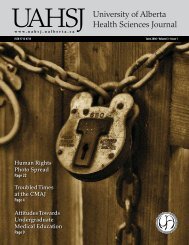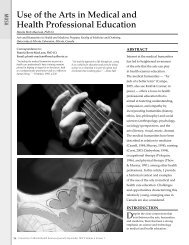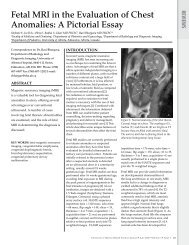Complete Issue PDF - University of Alberta Health Sciences Journal
Complete Issue PDF - University of Alberta Health Sciences Journal
Complete Issue PDF - University of Alberta Health Sciences Journal
- No tags were found...
Create successful ePaper yourself
Turn your PDF publications into a flip-book with our unique Google optimized e-Paper software.
MUSAto four weeks in hospital, with two to threeweek breaks outside. 10Generally, acromiothoracic flaps wereutilized for deep unilateral burns, but incases where adequate free grafts could beproduced, patients were treated in thisway entirely. 8 During his tenure at QueenVictoria hospital, Tilley would replacecountless noses, reform a multitude <strong>of</strong> earsand eyelids, and re-establish facial featuresfor hundreds <strong>of</strong> men; all <strong>of</strong> this with theobjective <strong>of</strong> giving his patients the chanceto return to a normal state <strong>of</strong> existence. ButTilley’s operative virtuosity was not all he<strong>of</strong>fered his patients….A Scalpel, A Guinea Pig, And ATender Hand: Tilley’s ApproachTo The Patient RelationshipBy 1944, the Canadian wing at QueenVictoria Hospital opened, and Tilley waspromoted to the rank <strong>of</strong> Group Captain.In June <strong>of</strong> the same year, Tilley foundhimself standing in front <strong>of</strong> King GeorgeVI at Buckingham Palace with the Order <strong>of</strong>the British Empire being bestowed uponhim. 1 This prestigious award was fittingrecognition <strong>of</strong> Tilley’s success in Britain;along with the work <strong>of</strong> McIndoe and thehospital staff, they had become “the mostformidable and effective response to burninjuries, anywhere in the world.” 4The work at Queen Victoria hospital was sogroundbreaking that it brought one patientto remark in jest, “we’re nothing but abunch <strong>of</strong> damn guinea pigs!” Subsequently,the Guinea Pig Club was formed in 1941,by a group <strong>of</strong> airmen who had sufferedburn injuries in the war and were treatedat the Queen Victoria Hospital. Consisting<strong>of</strong> nearly 650 members <strong>of</strong> a dozen differentnationalities, the club was one <strong>of</strong> the firstsupport groups in medical history. 17 TheFigure 5. Tilley poses for a photo symbolizing thecare he gave to his real patients, the Guinea Pigs.camaraderie and sense <strong>of</strong> belonging fosteredby the club has been acknowledged bymany historians as instrumental in thetherapeutic success ultimately achievedat East Grinstead. 4 The Guinea Pig Clubhelped shield patients from suffering theirdisfigurement in isolation, and gave itsmembers the strength to venture out intothe world, and walk the streets wearing theirwounds as testaments <strong>of</strong> their sacrifice. Tilleyserved as president <strong>of</strong> the Canadian branch<strong>of</strong> the Guinea Pig Club, and continued tooperate on over two hundred <strong>of</strong> its membersfor the next forty years (Figure 5). 3Tilley dedicated a tremendous amount <strong>of</strong>personal attention to the emotional andpsychological condition <strong>of</strong> his patients. Afteroperating all day and into the evening, Tilleywould rest briefly in his living quarters onlyto make his way back to the hospital at 23:00h to check how his patients were faringafter their surgeries. 4 In a medical landscapedominated by rampant paternalism,Tilley was a trailblazing pioneer <strong>of</strong> patientempowerment who went to great lengthsto educate his patients about every aspect<strong>of</strong> their care, every nuance <strong>of</strong> their surgeries,and the intricate details <strong>of</strong> what they couldexpect during recovery. 18 Where manysurgeons <strong>of</strong> the day saw their involvementin patient care beginning and ending in theoperating room, Tilley was a fierce proponent<strong>of</strong> the importance <strong>of</strong> a patient’s psychologicalwellbeing in their overall rehabilitation. In hiscare <strong>of</strong> the Guinea Pigs, Tilley transcendedthe customary duties <strong>of</strong> a physician and roseto become a shining light that illuminated acomprehensive path to recovery. 18For decades after the war, Guinea Pigsfrom across the world would come togetherfor an annual celebration where one <strong>of</strong>their toasts was always to the care theyreceived from Tilley. Out <strong>of</strong> gratitude forTilley’s commitment to them, the GuineaPig Club funded a bronze bust <strong>of</strong> theirbeloved physician, which was installed inthe Canadian wing <strong>of</strong> the Queen VictoriaHospital. The sculpture commemorates theman whose tender hand pulled them fromthe furnace, and allowed them to transcendwhat had once been thought <strong>of</strong> as a fateworse than death. 2No Sign Of Slowing Down:Tilley’s Life After The WarUpon his return from Britain in 1945, Tilleybecame a consulting physician at ChristieStreet Hospital and Toronto WellesleyHospital. For several years between 1949-1965, Tilley also spent three days everymonth in Kingston where he worked as astaff physician at the Hotel Dieu, KingstonGeneral, and Kingston Military Hospitals. 2As one <strong>of</strong> only ten other plastic surgeonspracticing in Canada after the war ended,Tilley was extremely busy laying theframework for the future <strong>of</strong> his specialty.His colleagues viewed Tilley as a physiciancapable <strong>of</strong> breaking new ground. In July <strong>of</strong>1942, he led the first all-Canadian plasticsurgery operation, and a few years later asan assistant pr<strong>of</strong>essor at Queens <strong>University</strong>,he became the first to <strong>of</strong>fer formal accreditedcourses in the specialty. 2 Tilley also inventedseveral surgical instruments, such as aningenious hand splint, and was the first to19, 20design the tube pedicle flap.Tilley was one <strong>of</strong> the twelve foundingfathers <strong>of</strong> the Canadian Society <strong>of</strong> PlasticSurgeons in 1947. At its second annualmeeting on June 2, 1948, the society’smembers empowered Tilley to draft a feeschedule for the operations performed mostcommonly by plastic surgeons. 20 Appointedvice-president in 1953, and then presidentin 1954, Tilley’s leadership <strong>of</strong> The CanadianSociety <strong>of</strong> Plastic Surgeons helped establishthe pr<strong>of</strong>ession in Canada and paved the wayfor the exponential growth and prosperity itwould experience in subsequent years. 20As his specialty flourished across thecountry, Tilley continued to infuse hisdiscipline with respect and integrity ashe campaigned for years to develop burntreatment facilities in Ontario. In 1984, hisvision came to fruition and the Ross TilleyBurn Centre opened at Wellesley Hospital. 21Only three years after becoming the firstplastic surgeon to be appointed a member<strong>of</strong> the Order <strong>of</strong> Canada, Tilley also assumedthe role <strong>of</strong> Founder and Director <strong>of</strong> the first19, 21adult burn centre in Canada.Even after retiring from practice at Wellesleyand Sunnybrook hospitals in 1981,Tilley continue to be recognized for hisoutstanding career. An elementary school inhis hometown <strong>of</strong> Bowmanville was namedin his honour, and he was inducted intoCanada’s Aviation Hall <strong>of</strong> Fame in 2006. 1,3After dedicating much <strong>of</strong> his 84 years <strong>of</strong> lifeto his patients, Albert Ross Tilley passedaway on April 19, 1988. 21CONCLUSIONThe distinguished and illustrious career<strong>of</strong> Albert Ross Tilley exemplifies many <strong>of</strong>the qualities sought after by physicianstoday. As a surgeon, he is rememberedfor his meticulous technical skill, soundjudgment, and tireless work ethic. He wasa leader, innovator, and educator whoseefforts sculpted an immature specialty intoa refined pr<strong>of</strong>ession. As a man, Tilley’s virtueand character stood beyond reproach, and34<strong>University</strong> <strong>of</strong> <strong>Alberta</strong> <strong>Health</strong> <strong>Sciences</strong> <strong>Journal</strong> • April 2012 • Volume 7 • <strong>Issue</strong> 1






